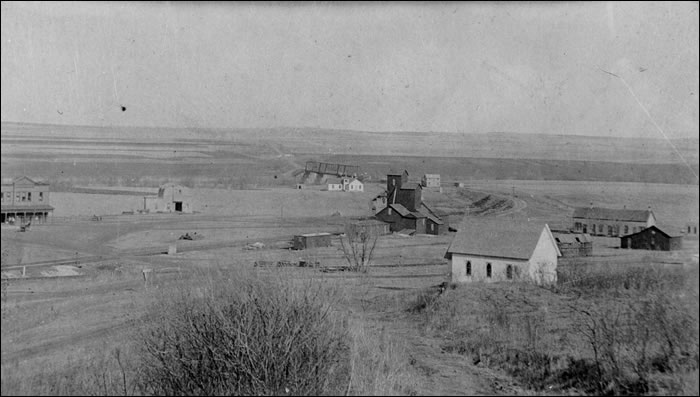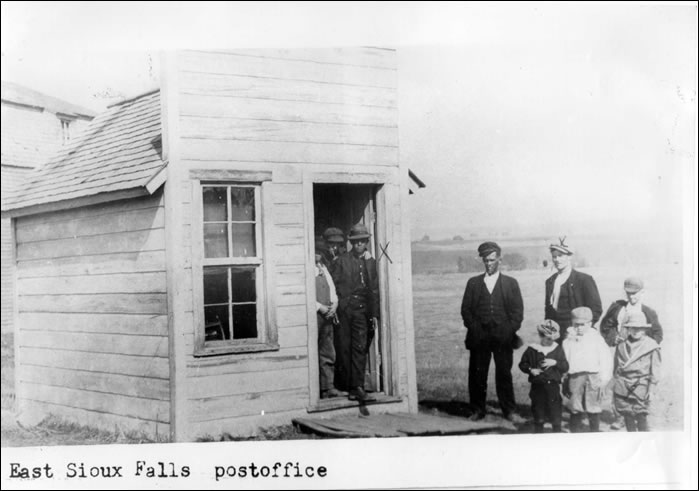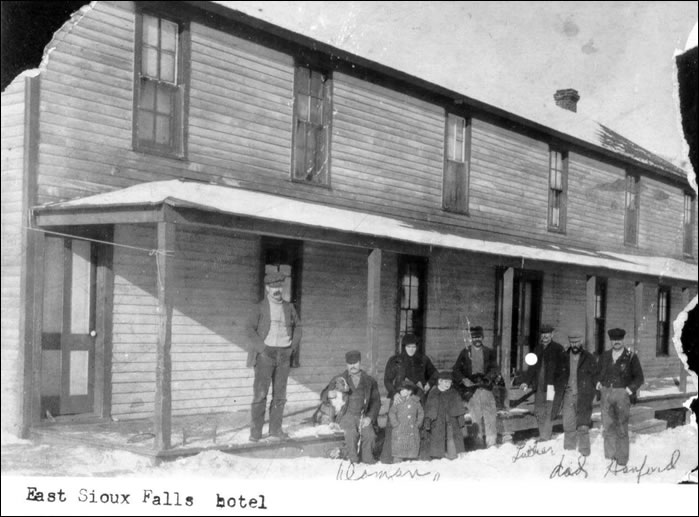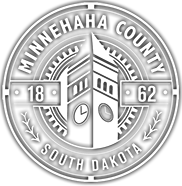By the 1880s, the quarry business in Sioux Falls had developed on a limited basis. Enticed by the abundance of quartzite along the bluffs of the Big Sioux River, partners C. W. Hubbard and James E. Riley expanded their quarry operation into Split Rock Township six miles east of downtown. This occurred in 1887 with the building of the town of Ives, the predecessor to East Sioux Falls. As the photo shows, the rock was just below the surface so it could be removed with relative ease. The following year the two men formed the Sioux Falls Granite Company.
Hubbard and Riley took a chance by investing in a site that did not have rail, or this could have been no more than a calculated risk because Sioux Falls officials had already begun negotiations with the Illinois Central Railroad to extend the rail line from Iowa through Sioux Falls. Rail officials demanded a financial commitment so pledges were secured including a contribution from Hubbard and Riley, and construction of the line commenced in the summer of 1887. The emerging quarries undoubtedly influenced the routing of the rail line through Ives.
In September of 1887, construction began on the railroad bridge across the Big Sioux River just east of Ives. By early December the rail reached Ives and the project was completed to Sioux Falls by year end. It had taken six months to extend the rail line from Cherokee, Iowa. Nearly a century later the Illinois Central would abandon the line, remove the rail and sell the right-of-way. The present day photo shows the piers that once supported the river bridge.
The railroad depot was built by the Illinois Central in 1888. The station was named East Sioux Falls, relegating the town of Ives to the historical records. Although East Sioux Falls was born from the stone quarries, it grew to boomtown status because of the railroad.
Paving block and building stone could now be transported by rail to major metropolitan markets. The quarried stone was moved by tram cars to cutting areas called “motions”. Each stone cutter had his individual motion. The tram cars also supplied rock to the crusher and loading points on the main line track.
Highly skilled craftsmen cut the stone into various shapes and sizes. Many of the workers who came to East Sioux Falls had migrated to America from Europe where the stone cutting trade had been learned. A common disease among the workers was “stone cutter’s consumption”, the result of breathing in the fine dust particles released by chipping the stone. The lives of many workers were cut short from this disease.
One of the most recognizable structures constructed from the stone at the East Sioux Falls quarries is the Minnehaha County Courthouse, or Old Courthouse Museum as it is now known. The building is at the corner of 6th Street and Main Avenue in downtown Sioux Falls and was completed in December of 1889 by the Sioux Falls Granite Company at a cost of $80,000. The workmanship of the stone craftsmen is evident in the building and its landmark clock tower. The structure has been restored by Minnehaha County and is part of the Siouxland Heritage Museum system.
 |
 |
 |
It was 1888 that much of East Sioux Falls was built to accommodate the quarry workers and their families. The accompanying photos display several of the buildings that rose from the prairie during this time. By 1890, East Sioux Falls boasted of hotels, boarding houses, stores, post office, saloon and several houses. The railroad bridge across the Big Sioux River can be seen in the background of the town site photo. According to estimates, East Sioux Falls had reached a population of 620 by this time and residents petitioned for a city charter. Voters cast ballots on August 19, 1890 in favor of incorporation.
In 1890, the South Dakota Rapid Transit & Railway Company constructed an electric motor line between Sioux Falls and East Sioux Falls. Sioux Falls officials hoped the line would encourage the quarry workers to live in the city and commute out to their jobs, a convenient one-half hour trip each way. Workers rejected this opportunity, opting instead to live near the quarries thereby contributing to the rapid growth of East Sioux Falls. But the motor line did become popular among Sioux Falls residents who traveled to East Sioux Falls to participate in its colorful lifestyle, social events and to visit the “Park” where the beauty of the hills and wooded area along the Big Sioux River was displayed. The motor line ceased operations in 1897.
The decline of East Sioux Falls occurred just as suddenly as its birth. The depression of 1893 and a shift away from stone as a building and paving material decreased quartzite production and forced workers to move elsewhere for jobs. The quarry industry struggled to survive and eventually the Sioux Falls Granite Company was forced into bankruptcy. There were several attempts to revive the once thriving quarries, including a new company named the East Sioux Falls Quarry Company managed by G. H. Perry.
The company ceased business with Perry in control of the quarry lands and the town site of East Sioux Falls. By 1913, only a few residents remained and East Sioux Falls was forced to give up its charter. The town site was in the Perry family for over a century before being donated to Minnehaha County in 1999. The 23-acre site known as Perry Nature Area is a public use area that preserves the natural beauty and historic features of the property.
Historic photos courtesy of Siouxland Heritage Museums.
Where The Sioux River Bends' by Wayne Fanebust includes a detailed history of East Sioux Falls.
| Main County Contact Information Minnehaha County Commission Office 415 N. Dakota Ave. Sioux Falls, SD 57104 Hours: 8:00 a.m. - 5:00 p.m. |
Accessibility Policy | Email Updates | ||
|---|---|---|---|---|
| Terms and Conditions | You Tube Video | |||
| Contact | Language Translate | |||
| Bookmark Us | ||||
© Copyright 2024 Minnehaha County
